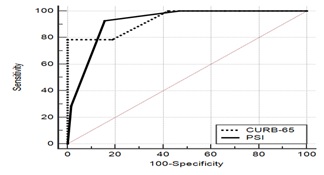Predictive accuracy of CURB-65 as comparedto PSI scorein the severity assessment of community acquired pneumonia
Abstract
Introduction: Pneumonia Severity Index (PSI) and CURB-65 rule for community acquired pneumonia (CAP) have been developed to stratify patients based on mortality. Lack of a risk stratifying score like PSI or CURB-65 can lead to significant delay in starting treatment. This study was conducted to find out the ability of CURB-65 score and PSI to predict clinically relevant outcomes.
Methods: 78 patients diagnosed as CAP admitted to a tertiary care hospital were enrolled into the study. Detailed clinical history was noted and CURB-65 and PSI scores were given with the help of a structured questionnaire in <24 hours of admission. The patients were revisited at day 3 and at discharge and data collected.
Results:Out of 78 patients included in the study, 60 were males and 18 were females. Of the 78 patients, 14 died accounting for aninhospital mortality of 17.94%. Mortality in the mild, moderate and severe groups of CURB-65 were 0%, 16.7% and 47.8% respectively. Mortality in the mild, moderate and severe groups of PSI were 1.8%, 50% and 80% respectively. Area under the curve (AUC) for CURB-65 and PSI in terms of inhospital mortality were 0.935 and 0.920 respectively.
Conclusion:The CURB-65 and PSI scores correlated well with mortality and other severity indicators. The CURB-65 has a better discriminatory power than PSI inour study. Because of its simplicity in addition to its better discriminatory power than PSI, CURB-65 may be better suited as a severity scoring system in CAP.
Downloads
References
Shah BA, Ahmed W, Dhobi GN, et al. Validity of pneumonia severity index and CURB-65 severity scoring systems in community acquired pneumonia in an Indian setting. Indian J Chest Dis Allied Sci. 2010 Jan-Mar;52 (1):9-17.
Lim WS, Baudouin SV, George RC, Hill AT, et al. BTS guidelines for the management of community acquired pneumonia in adults: update 2009. Thorax. 2009 Oct;64 Suppl 3:iii1-55. doi: http://dx.doi.org/10.1136/thx.2009.121434.
Lieberman D, Schalaeffer F, Boldur I, Liebermam D, Horowitz, Friedman MG, et al. Multiple pathogens in adult patients admitted with community acquired pneumonia: a one year prospective study of 346 consecutive patients. Thorax. 1996;51(2):179-84. DOI: http://dx.doi.org/10.1136/thx.51.2.179.
Bansal S, Kashyap S, Pal LS, et al. Clinical and bacteriological profile of community acquired pneumonia in Shimla, Himachal Pradesh. Indian J Chest Dis Allied Sci. 2004 Jan-Mar;46(1):17-22.
Rafael Lozano, Mohsen Naghavi, Kyle Foreman, Stephen Lim, Kenji Shibuya, Victor Aboyans et al. Global and regional mortality from 235 causes of death for 20 age groups in 1990 and 2010: a systematic analysis for the Global Burden of Disease Study 2010. The lancet. 2012;380(9859):2095-128. Doi: https://doi.org/10.1016/S0140-6736(12)61728-0.
Ritesh Sharma, Ram Deoskar, MedhaBargaje, Prashant Kumar, Yogesh Agarwal. A study of etiological and clinical profile of community acquired pneumonia in a tertiary care hospital in Western India. European Respiratory Journal. 2013;42(57):P2766
Guest JF, Morris A. Community-acquired pneumonia: the annual cost to the National Health Service in the UK. Eur Respir J. 1997 Jul;10(7):1530-4.
Lim WS, van der Eerden MM, Laing R, et al. Defining community acquired pneumonia severity on presentation to hospital: an international derivation and validation study. Thorax. 2003 May;58(5):377-82. DOI: http://dx.doi.org/10.1136/thorax.58.5.377.
Fine MJ, Auble TE, Yealy DM, et al. A prediction rule to identify low-risk patients with community-acquired pneumonia. N Engl J Med. 1997 Jan 23;336(4):243-50.
Ewig S, de Roux A, Bauer T, et al. Validation of predictive rules and indices of severity for community acquired pneumonia. Thorax. 2004 May;59(5):421-7. DOI: http://dx.doi.org/10.1136/thx.2003.008110.
Capelastegui A, España PP, Quintana JM, et al. Validation of a predictive rule for the management of community-acquired pneumonia. Eur Respir J. 2006 Jan;27(1):151-7.
Aujesky D, Auble TE, Yealy DM, et al. Prospective comparison of three validated prediction rules for prognosis in community-acquired pneumonia. Am J Med. 2005 Apr;118(4):384-92. DOI: https://doi.org/10.1016/j.amjmed.2005.01.006.
Warren JL, Bacon WE, Harris T, et al. The burden and outcomes associated with dehydration among US elderly, 1991. Am J Public Health. 1994 Aug;84(8):1265-9.DOI: https://doi.org/10.2105/AJPH.84.8.1265.
Loh LC, Khoo SK, Quah SY, et al. Adult community-acquired pneumonia in Malaysia: prediction of mortality from severity assessment on admission. Respirology. 2004 Aug;9(3):379-86. DOI: https://doi.org/10.1111/j.1440-1843.2004.00604.x.
Buising KL, Thursky KA, Black JF, et al. A prospective comparison of severity scores for identifying patients with severe community acquired pneumonia: reconsidering what is meant by severe pneumonia. Thorax. 2006 May;61(5):419-24. Epub 2006 Jan 31.
Ewig S, Kleinfeld T, Bauer T, et al. Comparative validation of prognostic rules for community-acquired pneumonia in an elderly population. Eur Respir J. 1999 Aug;14(2):370-5.
Rosón B, Carratalà J, Dorca J, et al. Etiology, reasons for hospitalization, risk classes, and outcomes of community-acquired pneumonia in patients hospitalized on the basis of conventional admission criteria. Clin Infect Dis. 2001 Jul 15;33(2):158-65. Epub 2001 Jun 15.DOI: https://doi.org/10.1086/321808.
Khan Y, Pednekar S, Pandey D. Pneumonia Severity Index In Predicting Outcome In Elderly Patients With Community Acquired Pneumonia At A Tertiary Level Hospital In Mumbai. Ann. Int. Med. Res. 2018;4(3):ME47-ME51.



 OAI - Open Archives Initiative
OAI - Open Archives Initiative


